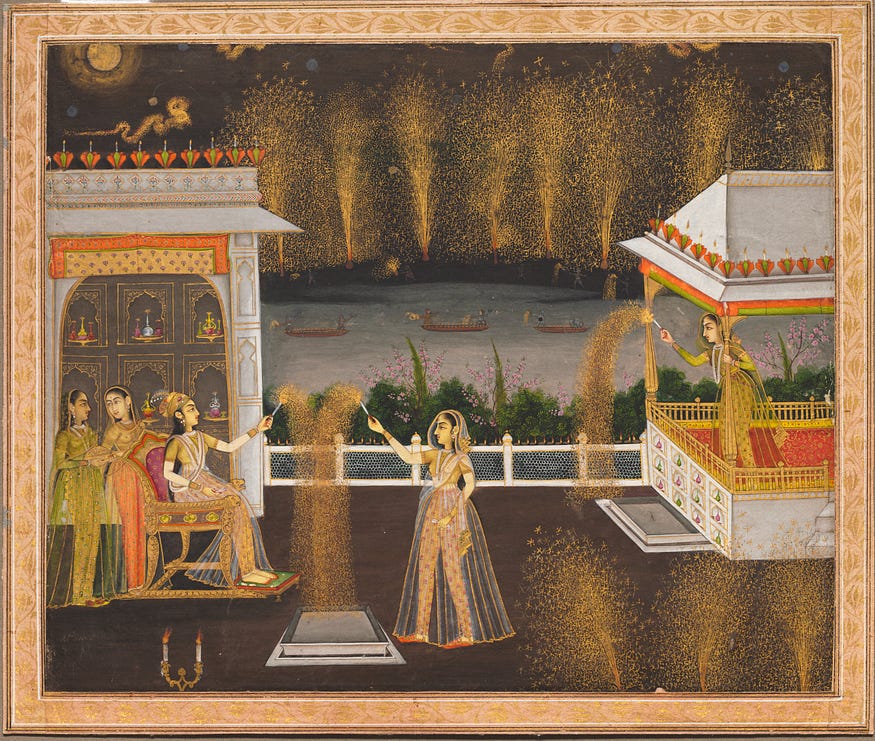Let’s Light Up the Skies
- Blog Post
- Collection
Illuminating the Festive History of Fireworks

Fireworks have long been a festive July tradition for children and adults alike. They are a spectacle that usually continues through the rest of the month (somewhat unfortunately for most furry members of the family). We are used to admiring the variety of colors and shapes bursting into the night sky. But fireworks were not always so intricate; in fact, the creation of fireworks was unintentional.

It is widely believed that the first fireworks were developed in Liuyang, China, around 200 BC. At that time, natural firecrackers were made of bamboo stalks. When thrown in a fire, they would explode due to overheating air pockets in the bamboo. Firecrackers were used during New Year festivals and to keep away evil spirits.
Years later, around AD 800, a Chinese alchemist created a version of gunpowder that was inserted into bamboo stalks or paper tubes and finished with a fuse made of tissue paper. The explosive result — the first fireworks — was unplanned, as the alchemist’s original hope was that the mixture would help reveal the secret to eternal life! Growing in popularity, this version of fireworks was used to used to ward off malevolent beings during celebrations of births, weddings, holidays, and coronations as a way to scare off evil spirits. While the early stages of fireworks were set off by throwing the bamboo or paper tubes into a fire, by the 10th century they became airborne when firecrackers were attached to arrows which were shot at enemies. This design was modified into rocket cannons and is similar to the technology that is used for fireworks today.
In the 13th century, with the revival of the Silk Road trade route, the recipe for gunpowder made its way to Europe via the Mongols. With additional knowledge from diplomats, explorers, and missionaries, Europeans experimented with the technology to create cannons and muskets. However, fireworks still retained a widespread appeal and were used in celebrations to entertain crowds throughout medieval England.
The first royal display of fireworks is estimated to have occurred on Henry VII’s wedding day in 1486. The fireworks presentation at James II’s coronation nearly 200 years later was so impressive that the fire master responsible was awarded a knighthood.

During the Renaissance, students were eager to study explosions at pyrotechnic schools. In Italy, trace amounts of metals and other ingredients were added to fireworks to increase their brightness and to make recognizable shapes. The Italians also created mixtures of various chemicals to produce fireworks of different colors. Up until this point in history, all fireworks were orange.
This print from the early 1600s captures the growing popularity of fireworks at the time, as a large crowd gathers around a brilliant spectacle unfolding over the Arno River in Florence. If you look closely, you can see some boats in the water surrounding the fireworks as they’re ignited.
As Europeans traveled to the New World, their recipes for fireworks spread. Around this time, there were designated fire masters and “green men” who orchestrated performances. Green men were so named because of the leaves they wore to protect themselves from sparks. They would also tell jokes to entertain the crowd while they prepared the fireworks exhibition.

While the fashionable protective outfit portrayed in this print isn’t made of leaves, it features elaborate armor, including a helmet that appears to spray its own pyrotechnics into the sky.

This painting from Northern India presents a princess on a golden armchair as she lights sparklers with her friends in celebration of a New Year festival. In the boats and on the far shore, men set off sparklers amid the glow of a magnificent fireworks show under the full moon.

During the 1850s, restaurants and other businesses along the Sumida River near present-day Tokyo frequently sponsored dazzling displays like the one depicted in this print. The pyrotechnic performances drew large crowds, who gathered atop bridges, along the shore, in tea shops, and on boats to enjoy the show.

Capturing the magic of fireworks using a camera is no easy task! Photographer Josef Breitenbach used a camera-less technique, the photogram, which involves placing objects directly onto the surface of a light-sensitive material such as photographic paper and then exposing it to light. Here, the process helps transform a dandelion into an imaginative fireworks display.
At last, fireworks became a Fourth of July tradition when they were set off on the Declaration of Independence’s first anniversary, July 4, 1777, in Philadelphia.
Find these artworks and more fireworks in CMA’s Collection Online by searching “fireworks”. Create your own fun, firework-themed art by using straws and paint to create your own fireworks spectacle like the one shown here.

Sources:
https://www.celebratesafely.org/history-of-fireworks
https://www.livescience.com/63468-fireworks-history.html